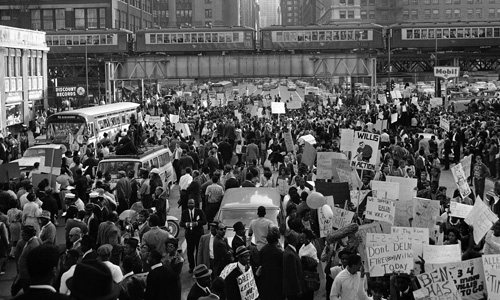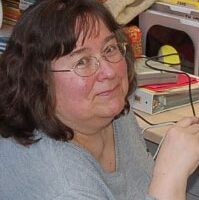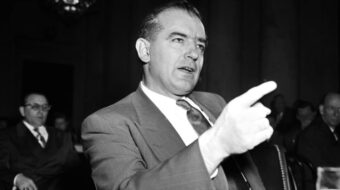
On October 22, 1963, a coalition of civil rights groups organized Freedom Day, a mass boycott and demonstration against segregated schools and inadequate resources for black students. Almost half of Chicago’s public school students skipped class, leaving many schools on the predominantly black South and West Sides virtually empty.
Public schools in black neighborhoods were often outdated and always overcrowded. The Chicago Board of Education’s answer to overcrowding was to have double-shifts at some schools. Double-shifts meant that students in affected schools attended less than a full day of class. In another measure, at some schools the Board sanctioned the construction of mobile classroom units.
In addition to overcrowding, CPS faculty was segregated, and the history curriculum then did not mention African Americans.
The climax of Freedom Day was the march by students, parents, teachers and supporters to the downtown office of the Chicago Board of Education. Thousands took to the streets, carrying signs that voiced their frustrations. Police met the nearly 10,000 protestors and prevented them from entering the Chicago Board of Education building.
One group organizing Freedom Day was the Coordinating Council of Community Organizations They helped black parents stage sit-ins against overcrowded schools and pursued legal action against school segregation. In 1964 Al Raby, a black schoolteacher, was elected convener of CCCO.
Another group involved in Freedom Day was the Congress of Racial Equality or CORE, founded in Chicago in 1942.
CORE sought to apply the principles of nonviolence as a tactic against segregation. The group’s inspiration was Mahatma Gandhi. Employing non-violent civil disobedience, Gandhi led India to independence and inspired movements for non-violence, civil rights and freedom across the world.
Gandhi had, in turn, been influenced by the writings of 19th century American writer Henry David Thoreau, author of Civil Disobedience, an argument for individual resistance to government in moral opposition to an unjust state.
In the South, CORE’s nonviolent direct action campaigns opposed “Jim Crow” segregation and job discrimination, and fought for voting rights. Outside the South, CORE focused on discrimination in employment and housing, and also in de facto school segregation.
In 1960, the Chicago chapter of CORE began to challenge racial segregation in the Chicago Public Schools (CPS).
The massive Freedom Day protest ignited more demonstrations, each demanding an end to segregation in Chicago. Change occurred slowly, but this activism led to increasing support for integration and a fairer chare of resources, while it revealed that racial segregation extended beyond the south.
In September of 2012, the attack on public education in Chicago led to a strike of nearly 30,000 teachers, nurses, librarians, counselors, social workers, aides and paraprofessionals.
The Chicago Teachers Union was fighting for a collaborative voice in any education reform and sought quality, fully funded public education, with smaller class sizes, fully staffed schools and a curriculum rich in art, music, physical education and language at every school.
Teachers saw their fight as bettering not only their pay and benefits, but more importantly working and learning conditions benefiting the students.
Contributing to this story: Chicago History Museum’s Facing Freedom website (with photos and newsreel footage), The Encyclopedia of Chicago, Wikipedia
Photo: Crowd fills LaSalle Street between City Hall and building housing Board of Education as thousands of demonstrators marched in Chicago on Oct. 22, 1963, protesting school segregation. Paul Cannon/AP










